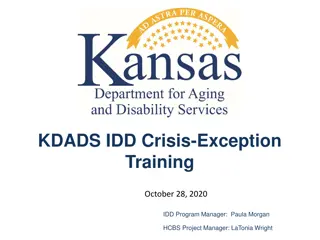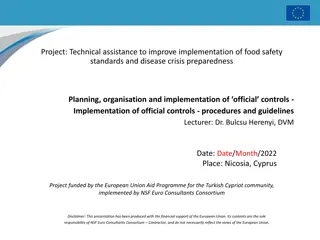Key Aspects of Crisis Management and Preparedness in Financial Institutions
This presentation delves into the critical components necessary for reducing the Too Big to Fail problem in financial institutions. It emphasizes the importance of comprehensive recovery and resolution planning to prevent government bailouts and mitigate losses effectively. The Key Attributes of Effective Resolution Regimes, recent advances, and recovery strategies for Global Systemically Important Financial Institutions (G-SIFIs) are explored to enhance stability and resilience within the financial sector.
Download Presentation

Please find below an Image/Link to download the presentation.
The content on the website is provided AS IS for your information and personal use only. It may not be sold, licensed, or shared on other websites without obtaining consent from the author.If you encounter any issues during the download, it is possible that the publisher has removed the file from their server.
You are allowed to download the files provided on this website for personal or commercial use, subject to the condition that they are used lawfully. All files are the property of their respective owners.
The content on the website is provided AS IS for your information and personal use only. It may not be sold, licensed, or shared on other websites without obtaining consent from the author.
E N D
Presentation Transcript
Crisis Management and Crisis Preparedness October 22, 2014 Presented at the 13thAnnual IADI Conference Port of Spain, Trinidad
Disclaimer The views expressed in this presentation are the speaker s and not those of the Federal Reserve Bank of New York and the Federal Reserve System.
Overview Reducing the Too Big to Fail problem and avoiding government bailouts: a two-pronged strategy. Reducing the probability of failure for such firms Increasing the ability to put complex firms into resolution Increasing the likelihood that firms develop meaningful recovery plans and activate them early reduces losses and preserves value. Breakthroughs have been made in achieving the resolution of a systemically important financial institution. . Publication of the Key Attributes of Effective Resolution Regimes Development of the single point of entry resolution strategy Emerging thinking on the means for recapitalization and funding of a financial institution in resolution Efforts to improve cross-border recognition of resolution actions and stays of financial contracts, especially derivatives Work remains: progress on resolution is a journey.
Recent AdvancesThe Key Attributes The Key Attributes of Effective Resolution Regimes (November 2011) Makes the case for special insolvency regimes for financial institutions all financial institutions, large, small, bank, nonbank Sets out powers needed by financial resolution authorities Recommends that resolution regimes have the ability to use a bridge bank or bridge institution Introduces the concept of bail-in within resolution of at least some financial liabilities of the firm Sets out guidelines for recovery and resolution planning for G- SIFIs, systemically important financial institutions designated by the Financial Stability Board. Much progress in major jurisdictions in adopting legislation that implements the Key Attributes. Most notably in 2014, in the European Union,
Recovery and Resolution Planning for G-SIFIs The Key Attributes sets out objectives for recovery and resolution planning for those financial firms designated as G- SIFIs. Each G-SIFI has a Crisis Management Group (CMG) made up of the lead and major home authorities and major jurisdictions in which the G-SIFI is active. The Cross-Border Crisis Management Group (CBCM) is the forum where the key jurisdictions can bring forward issues of mutual interest for study and for coordinating their approaches. CBCM reports to the Resolution Steering Group Recovery planning was completed for most G-SIFIs in 2011. Resolution strategies were chosen for most G-SIFIs in 2012. Operational plans for resolution are being developed now. Likely to be an iterative process.
Status of Recovery and Resolution Planning Recovery plans for G-SIFIs are completed and have often been through a few iterations. Resolution strategies have advanced substantially: High-level strategies were identified by each CMG last year. An operational plan was developed and approved by the CMG this year. CMGs are making a resolvability assessment. Cooperative Agreements are being signed by parties within the CMG and senior-level discussions of the resolution plan and the resolvability assessment (RAP) for each G-SIFI) are being discussed. The round of RAP discussions should end in the first half of next year.
Recovery Planning, a Key Risk Management Activity Recovery planning by a financial firm identifies possible actions it can take when problems develop. Those actions are aimed first at stabilizing the firm and then at working toward a resumption of business health and profitability. Historical experience suggests that financial firms minimize financial losses and other costs by identifying emerging problems early and taking prompt, proactive steps to address them. Recovery planning relies on scenario analysis in order to identify stress points and the rough size of actions that may need to be taken. Scenarios need to include both firm-specific and marketwide stresses. Therefore, firms need to identify quantitative and qualitative triggers for consideration of options and actions by the firm. The triggers are not meant to automatically lead to specific actions, but they must lead to deliberation within the firm. After reviewing the initial recovery planning done by G-SIFIs, the CBCM set out in a paper (July 2013) considerations for sound scenario analysis for recovery planning and the design and key features of recovery triggers.
Recent Advance on Resolution: Single Point of Entry The failure of Lehman Brothers Holdings, Inc., in 2008 and the commencement of insolvency proceedings in multiple jurisdictions around the globe exemplified the problem of an uncoordinated resolution. The FDIC put forward in its Journal a paper describing how a new resolution strategy, single point of entry (SPE), could have been used to resolve Lehman Bros. The FDIC further elaborated in speeches and a joint paper by the FDIC and Bank of England. In the simplest form of single point of entry resolution, the resolution authority puts only the holding or parent company into resolution, and continues to operate the parent s subsidiaries as going concerns. The resolution authority can fund the sole legal entity in resolution and that entity can fund the subsidiaries. The resolution authority can then restructure and/or sell the financial company as necessary. SPE has been widely adopted by the CMGs for G-SIFIs.
Progress: Single Point of Entry Resolution The Financial Stability Board published guidance on developing effective resolution strategies (July 2013). The guidance describes the conditions leading a resolution authority to choose a single point of entry strategy, a multiple points of entry strategy, or some combination of both. Multiple points of entry (MPE) could cover a range of possibilities: regional breakup, business line breakup, good bank/bad bank, etc. Some prerequisites for MPE may be a large degree of financial and operational separation across legal entities/jurisdictions, as well as sufficient independent funding and loss-absorbing capacity at the potential points of entry. Single point of entry may have as prerequisite sufficient ability to move losses upstream and capital downstream in the organization; sufficient loss- absorbing capacity at the parent or a subsidiary that the parent can access, Supervisory and resolution authorities have expressed a strong desire to have flexibility in choosing the resolution strategy at the time of failure.
The Innovation of Bail-in Powers Key innovation: bail-in powers. Bail-in is intended to reduce the permanent capital/funding need from the public sector to zero. Bail-in is the power to convert liabilities to equity or write them down in value; in either case, bailing in liabilities creates new capital. Bail-in avoids a capital injection by public sector and strengthens the entity in resolution for sale, and improves its access to funding markets. Bail-in must be credible to not be destabilizing. In the failure of Washington Mutual, the FDIC wrote down senior debt, but the market assumed that senior debt would be protected in a failure.
Why Do We Need Bail-in Now? Bail-in is a mechanism to recapitalize a financial institution in resolution. Why do we need it now? Traditional commercial banking involves the taking of deposits and the lending of funds. In concept, traditional commercial banking businesses can be resolved, in part because the deposits generally have value, as do the good assets. To have value, deposits must be sticky not very sensitive to changes in interest rates or the institution s health. The stickiness comes from the account services (e.g., payment and liquidity services) that are intrinsic to the deposit. In contrast, capital market activities and other non-deposit funding activities have liabilities generally without stickiness one reason why bail-in is important.
Bail-in and Loss Absorbing Capacity in Resolution The equity capital of the firm is meant to absorb losses that could lead to a firm s failure and firms have generally depleted much of their capital as they enter resolution In resolution, other loss-absorbing liabilities are needed to recapitalize their firm and support its sale. Loss-absorbing capacity (LAC) involves identifying liabilities of the firm that can be converted into equity or written down in resolution (bailed-in). Liabilities can be rank-ordered by the effectiveness of their conversion and the absence of inducing further runs. Work advancing to the 2014 Brisbane Summit on what qualifies as LAC, how much is required and where the LAC could be located in the organization.
What Kind of Liabilities Can be Bailed-in? Key features: needs to predictably provide loss- absorbing capacity; needs to avoid triggering runs; needs to avoid de-stabilizing funding markets. Subordinated and senior debt most clearly bail-inable. Financial institutions may need to issue more. Derivatives liabilities and short-term funding seen as less suitable. Agreement that insured deposits should not be bailed in; also great reluctance to bail in uninsured deposits, reinforced by the Cyprus experience. Some discussion of using or crediting the potential use of deposit insurance as part of LAC
Funding in Resolution Resolution requires funding and liquidity Funding is necessary to support the balance sheet and meet collateral requirements Liquidity takes many forms, but a key one is access to trading markets, necessary in order to manage risk What problems can a firm face in funding in resolution? History suggests that loss of funding capacity occurs in the run-up to failure and continues after. What is the potential gap between the firm s resources and its funding needs? Capital markets activities depend on credit in the settlement process. When the firm is no longer viewed as credit- worthy, it may restrictions on its access to markets.
Recent Work on Funding in Resolution The CBCM has begun looking at funding in resolution. A review of previous cases of failure or near failure confirms that funding needs rise in and even after resolution. While funding eventually is restored, funding needs temporarily become very large. Improving the ability to estimate funding gaps prior to resolution taking into account bail-in is a clear need. Working to develop principles for ways to sustain as much private sector funding as possible is also a clear imperative. Principles to guide public sector funding when it is needed also look like they would be useful. In addition, much progress was made in identifying temporary funding approaches that minimize moral hazard. We do not want to be prescriptive as to how countries meet that need.
Other Noteworthy Areas of Progress Cross-border recognition of actions by resolution authorities, such as temporary stays of derivatives contracts and exercise of bail-in powers. Discussions with industry and the legal community have made progress. A paper has been written on resolution-related information sharing between home and host supervisors about financial firms whose operations in a host jurisdiction are locally systemic, but small relative to the overall firm s size and activities. Regional supervisory groups have provided extensive comments on the paper. The next step will be public consultation.
Progressing on the Journey: Future Work Considerable progress on resolution plans that do not require the taxpayer to bear losses, but much remains to be done. Ensure continued progress in adopting the insolvency regime requirements of the Key Attributes. With the first round of G-SIFI resolution planning nearing completion, a good time to assess the process and its integration into supervisory practice. Develop further topics such as operational continuity of critical operations through the resolution process. Further attention to the set of decisions that need to be made upon entry into resolution: management, valuation, strategies such as managing problematic assets. More detailed planning of roles and responsibilities: supervisors, resolution authorities, and deposit insurers.























